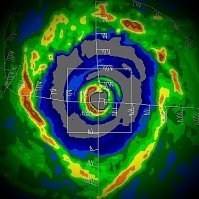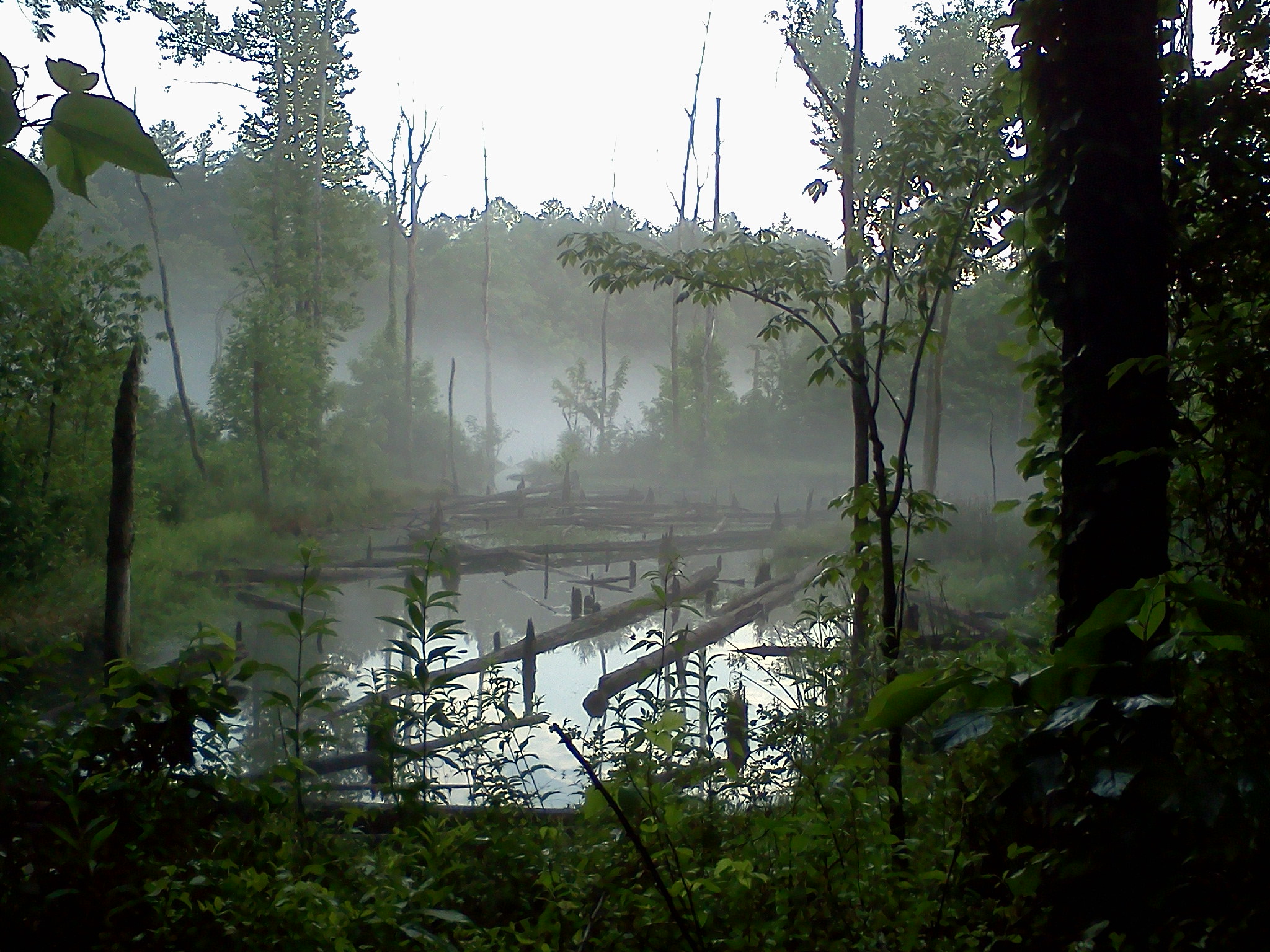-
Posts
4,715 -
Joined
-
Last visited
Content Type
Profiles
Blogs
Forums
American Weather
Media Demo
Store
Gallery
Everything posted by Windspeed
-
Impressive IR presentation given how inland Helene is now. Obviously, its rapid forward motion has a lot to do with the structure holding together so well. Perhaps some baroclinic enhancement to begin shortly with a hook left and phasing event with the ULL.
-
Steinhatchee getting blasted by onshore flow with the intense SE quadrant of the eyewall. Worst of the surge is likely occurring that location.
-
That is a heavily tree'd area near the coast. Going to be quite a mess.
-
Landfall point (center of eye) looks like it's going to be due SW of Perry at the Spring Warrior Fish Camp in the Big Bend Wildlife Management Area if current motion continues.
-
Perry is definitely getting the worst RF quadrant even if a more northerly track has commenced. The NE and E segments of the eyewall are too close to them now to be avoided.
-
Strong dualing VHTs are driving down central pressure. In turn, the gradient is sharpening/tightening. Recon showing a rapidly intensifying major hurricane now. It's going to be a long night.
-
Not even sure that was an ERC. I just think Helene has many of the same characteristics as WPAC typhoons that form out of large monsoonal gyres. With a large RMW embedded in lower surface background pressure regime, it takes time for a large eyewall band to consolidate and strengthen enough to kill off the nascent core hot garbage cells before cranking may begin. Otherwise, all the ingredients are there. High OHC, mass divergence aloft, jet streak. Just takes time; and hopefully, enough that Helene will run out of it before deep pressure falls and gradient-induced RMW contraction will allow MPI to be approached prior to landfall.
-
Pretty grim situation in Myanmar. Sometimes disciplines merge when catastrophe strikes. Super Typhoon Yagi inevitably resulted in a geological/geomorphological disaster due to thousands of landslides throughout the mountainous countryside within the country's interior. Many isolated communities dowstream are inundated due to sediments and mudflows clogging rivers and encompassing villages. Communication out of these remote places is slow, and it may be some time before we really learn the true scope/magnitude inflicted on the peoples that reside there.
-

Summer-Fall 2024 Weather Disco Med/Long Range
Windspeed replied to John1122's topic in Tennessee Valley
RE: Potential downsloping and wind gusts. Granted, this is just one model (HAFSB) and the most recent run. Hopefully, overdone.- 689 replies
-
- 3
-

-

-
- heat
- thunderstorms
- (and 7 more)
-
Done.
-
Talk, it's only talk Arguments, agreements Advice, answers Articulate announcements It's only talk Talk, it's only talk Babble, burble, banter Bicker, bicker, bicker Brouhaha, balderdash, ballyhoo It's only talk Back talk Talk talk talk It's only talk Comments, cliches, commentary, controversy Chatter, chit-chat, chit-chat, chit-chat Conversation, contradiction, criticism It's only talk Cheap talk Talk, talk, it's only talk Debates, discussions These are words with a D this time Dialog, duologue, diatribe Dissention, declamation Double talk, double talk Talk, talk, it's all talk Too much talk Small talk Talk that trash Expressions, editorials Explanations, exclamations, exaggerations It's all talk Elephant talk Elephant talk Elephant talk
-

Summer-Fall 2024 Weather Disco Med/Long Range
Windspeed replied to John1122's topic in Tennessee Valley
Some of these model runs now aggressively capture Helene, advancing its core into the Eastern Tennessee Valley with haste. I wonder if some record surface pressures may be broken. Also, the 850-700 hPa vorticity maximum remains intense all the way across the Smoky Mountains. Might some areas NE of the circulation experience some very high wind gusts due to downsloping effects with such a tight gradiant and E to ESE flow in the NE and E quadrant? Combined with saturated water-logged soils, becoming concerned about uprooted and downed trees. Most trees are still in full foliage.- 689 replies
-
- 6
-

-

-
- heat
- thunderstorms
- (and 7 more)
-

Summer-Fall 2024 Weather Disco Med/Long Range
Windspeed replied to John1122's topic in Tennessee Valley
Nice mosaic of the precipitation and moisture feed out of the GOM. This is all still due to the frontal/upper trough, which is getting cut off and driving south through the Mississippi Valley. A soaking pre to the PRE...- 689 replies
-
- 6
-

-

-
- heat
- thunderstorms
- (and 7 more)
-
It is interesting to note that all of the prominent TC models simulated this dry slot instrusion off of the Yucatán landmass at this juncture, and all have the core mixing that out by this evening.
-
[mention=9730]WxWatcher007[/mention] [mention=17109]NorthHillsWx[/mention] That dry slot you both were mentioning earlier seems to have been pulled into the developing core. Granted, I'm not sure how thorough the echoes are on the La Bajada radar, but perhaps this will help to keep Helene in check a bit longer until it can gain some separation away from the Yucatán landmass. Pretty much looking for anything to stunt or delay RI, which will make time an issue for Helene to reach MPI.
-
Radar suggests a more northerly motion has commenced as well in the past few hours.
-
Watching Helene evolve on radar out of Cancun and have only just realized that the echoes from there are somewhat deceiving. The mesos rotating towards Cancun that I thought were the onsets of a core are just that, mesos. I have been looking for a small initial core eyewall to develop. But the much larger LLC is indeed intensifying. Cuban radar shows this evolution much better. Helene has a large core developing. Notice the intense NE band while simultaneously strong cells are consolidating on the south side swiftly moving east. The Cancun radar appears heavily attenuated at the moment for some reason. Not sure if that is due to high wind or the array under high precipitation. Regardless, Helene is going to be a large hurricane. Cancun radar: Cuban radar:
-
Second VDM. They're heading home. 211 URNT12 KNHC 250713 VORTEX DATA MESSAGE AL092024 A. 25/06:53:00Z B. 20.29 deg N 085.86 deg W C. 850 mb 1322 m D. 985 mb E. 355 deg 7 kt F. NA G. NA H. 44 kt I. 134 deg 23 nm 06:46:30Z J. 226 deg 46 kt K. 133 deg 31 nm 06:44:30Z L. 65 kt M. 311 deg 26 nm 07:01:30Z N. 027 deg 51 kt O. 312 deg 27 nm 07:02:00Z P. 19 C / 1518 m Q. 25 C / 1519 m R. 14 C / NA S. 1345 / 08 T. 0.02 / 2.5 nm U. AF300 0909A HELENE OB 11 MAX FL WIND 58 KT 049 / 45 NM 05:40:00Z LTG NW QUAD ;
-
VDM reports a curved band in the NE quadrant. Core formation is most likely underway. Recon should make another pass and we'll see how quickly that is evolving while they're down there: 664 URNT12 KNHC 250620 VORTEX DATA MESSAGE AL092024 A. 25/05:54:30Z B. 20.30 deg N 085.93 deg W C. 850 mb 1321 m D. 986 mb E. 080 deg 8 kt F. NA G. NA H. 51 kt I. 053 deg 32 nm 05:44:00Z J. 119 deg 58 kt K. 049 deg 45 nm 05:40:00Z L. 52 kt M. 227 deg 25 nm 06:02:00Z N. 325 deg 54 kt O. 227 deg 36 nm 06:05:00Z P. 18 C / 1522 m Q. 26 C / 1541 m R. 12 C / NA S. 12345 / 08 T. 0.02 / 3 nm U. AF300 0909A HELENE OB 05 MAX FL WIND 58 KT 049 / 45 NM 05:40:00Z CURVED RADAR BAND IN NE QUAD, LESS THAN 50% COVERAGE ;
-
Recon 986 mb xtrap.
-
Hrmm... Granted, it's only been a few hours since I posted the last radar clip, but it does appear a ring of convection is trying to come together. Perhaps an core eye band is evolving now.
-
Here's a radar loop out of Cancun. The low-level and mid-level circulations look fairly aligned, but a core eyewall band has yet to evolve. Helene just isn't there yet as far as hurricane intensity. I'd say it needs at least another 12-18 hours for the organization to ramp up a core. Perhaps the Yucatán landmass may also aid in the LLC tightening due to friction. Also, it's going to be very close that the LLC doesn't actually cross over extreme NE Yucatán.
-
TEAL 71 had 25/0530Z scheduled on their plan as well. I am uncertain if that still remains.
-
Yes, but with flights scheduled through 12z tomorrow, they will likely wait on recon for in situ data for any upgrade unless something drastic occurs in satellite appears such as an eye forming within the CDO. I doubt that's going to happen in the next 12 hours. We probably wouldn't realistically see intensification result in an upgrade until 11AM at the earliest. Helene still has a lot of work to do tonight to organize its core and eyewall evolution. We also have Cancun radar to see this process evolve.
-
[code] FLIGHT THREE - TEAL 71 FLIGHT FOUR - NOAA 49 A. 24/2330Z,25/0530Z A. 25/1200Z B. AFXXX 0809A CYCLONE B. NOAA9 0909A CYCLONE C. 24/2100Z C. 25/0530Z D. 20.5N 85.0W D. NA E. 24/2300Z TO 25/0530Z E. NA F. SFC TO 15,000 FT F. 41,000 TO 45,000 FT G. FIX G. SYNOPTIC SURVEILLANCE H. NO WRA ACTIVATION H. NO WRA ACTIVATION FLIGHT FIVE - NOAA 43 FLIGHT SIX - TEAL 72 A. 25/1200Z A. 25/1130Z,1730Z B. NOAA3 1009A CYCLONE B. AFXXX 1109A CYCLONE C. 25/0800Z C. 25/0930Z D. 22.1N 86.0W D. 22.0N 86.0W E. 25/0900Z TO 25/1500Z E. 25/1100Z TO 25/1730Z F. SFC TO 15,000 FT F. SFC TO 15,000 FT G. TAIL DOPPLER RADAR G. FIX H. NO WRA ACTIVATION H. NO WRA ACTIVATION [/code]



